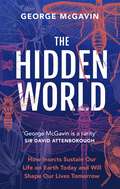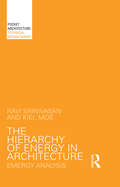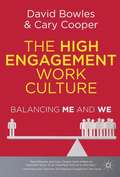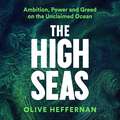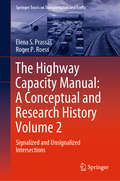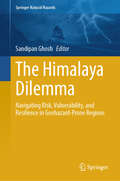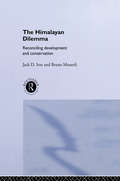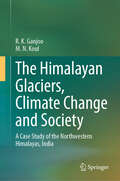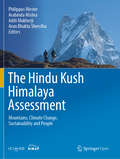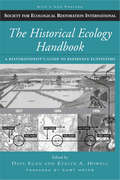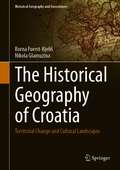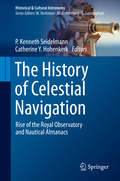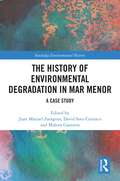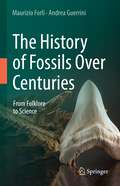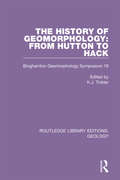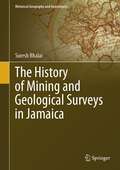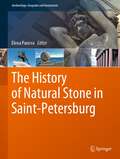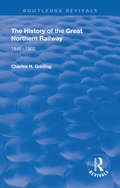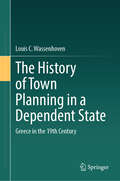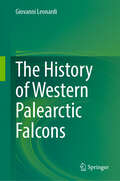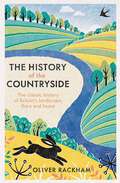- Table View
- List View
The Hidden World: How Insects Sustain Life on Earth Today and Will Shape Our Lives Tomorrow
by George McGavinInsects conquered the Earth long before we did and will remain here long after we're gone.They outnumber us in the billions and are essential to many of the natural processes that keep us alive and that we take for granted.Yet, despite this, very few of us know much about the hidden world of insects.In this fascinating new book, entomologist and broadcaster George McGavin takes a deep dive to reveal the unknown truths about the most successful and enduring animal group the world has ever seen, and to show the unseen effects this vast population has on our planet, if only we care to look.McGavin explores not only the incredible traits that insects have evolved to possess, such as dragonflies that can fly across oceans without resting or beetles that lay their eggs exclusively in corpses, but also the vital lessons we have learnt from them, including how therapy using maggots can save lives and how bees can help grow rich tomato yields.The Hidden World reveals the wonderful complexity of our relationship with insects, how they have changed the course of our history and how, if we continue to learn from them, they could even be the key to our future and survival.
The Hierarchy of Energy in Architecture: Emergy Analysis (PocketArchitecture)
by Ravi Srinivasan Kiel MoeThe laws of thermodynamics—and their implications for architecture—have not been fully integrated into architectural design. Architecture and building science too often remain constrained by linear concepts and methodologies regarding energy that occlude significant quantities and qualities of energy. The Hierarchy of Energy in Architecture addresses this situation by providing a clear overview of what energy is and what architects can do with it. Building on the emergy method pioneered by systems ecologist Howard T. Odum, the authors situate the energy practices of architecture within the hierarchies of energy and the thermodynamics of the large, non-equilibrium, non-linear energy systems that drive buildings, cities, the planet and universe. Part of the PocketArchitecture series, the book is divided into a fundamentals section, which introduces key topics and the emergy methodology, and an applications section, which features case studies applying emergy to various architectural systems. The book provides a concise but rigorous exposure to the system boundaries of the energy systems related to buildings and as such will appeal to professional architects and architecture students.
The High Engagement Work Culture
by Cary Cooper David BowlesThe 2008 crisis set off a systemic panic which almost engulfed the world's financial system. Through a lens of sustainability this book examines how organisations can explore a new business culture today. Drawing from real-life examples and new ideas Bowles and Cooper discuss how organisations can move from 'me' to 'we'.
The High Seas: Ambition, Power and Greed on the Unclaimed Ocean
by Olive Heffernan'A vital, fascinating, deeply researched exploration of Earth's last wilderness...Shocking and starkly illuminating - a must-read.' Gaia VinceThe ocean covers seventy per cent of the surface of our planet, and two thirds of this lie beyond national borders. Owned by all nations and no nation simultaneously, these waters are home to some of the richest and most biodiverse environments on the planet. But they are also home to exploitation on a scale that few of us can imagine.Here, industry and economic progress rule and lax enforcement and apathy are the status quo. Out of sight and often out of mind, a battle rages to control, profit from, protect, or obliterate the world's largest, wildest commons. Heffernan sets sail on a journey to uncover the truth behind deeply exploitative fishing practices, investigate the potentially devastating impact of deep-sea mining, and hold to task the Silicon-valley interventionists whose solutions to climate change are often wildly optimistic, radically irresponsible or both.The result is a forceful and deeply researched manifesto calling for the protection and preservation of this final frontier - the last vestiges of wilderness on Earth.
The High-Mountain Cryosphere
by John J. Clague Huggel, Christian and Carey, Mark and Clague, John J. and Kääb, Andreas Christian Huggel Mark Carey Andreas KääbThis edited volume, showcasing cutting-edge research, addresses two primary questions - what are the main drivers of change in high-mountains and what are the risks implied by these changes? From a physical perspective, it examines the complex interplay between climate and the high-mountain cryosphere, with further chapters covering tectonics, volcano-ice interactions, hydrology, slope stability, erosion, ecosystems, and glacier- and snow-related hazards. Societal dimensions, both global and local, of high-mountain cryospheric change are also explored. The book offers unique perspectives on high-mountain cultures, livelihoods, governance and natural resources management, focusing on how global change influences societies and how people respond to climate-induced cryospheric changes. An invaluable reference for researchers and professionals in cryospheric science, geomorphology, climatology, environmental studies and human geography, this volume will also be of interest to practitioners working in global change and risk, including NGOs and policy advisors.
The Highway Capacity Manual: Signalized and Unsignalized Intersections (Springer Tracts on Transportation and Traffic #12)
by Elena S. Prassas Roger P. RoessSince 1950, the Highway Capacity Manual has been a standard used in the planning, design, analysis, and operation of virtually any highway traffic facility in the United States. It has also been widely used around the globe and has inspired the development of similar manuals in other countries. This book is Volume II of a series on the conceptual and research origins of the methodologies found in the Highway Capacity Manual. It focuses on the most complex points in a traffic system: signalized and unsignalized intersections, and the concepts and methodologies developed over the years to model their operations. It also includes an overview of the fundamental concepts of capacity and level of service, particularly as applied to intersections. The historical roots of the manual and its contents are important to understanding current methodologies, and improving them in the future. As such, this book is a valuable resource for current and future users of the Highway Capacity Manual, as well as researchers and developers involved in advancing the state-of-the-art in the field.
The Himalaya Dilemma: Navigating Risk, Vulnerability, and Resilience in Geohazard-Prone Regions (Springer Natural Hazards)
by Sandipan GhoshThe Himalaya Dilemma: Navigating Risk, Vulnerability, and Resilience in Geohazard-Prone Regions is a collaborative effort to explore and understand the multiple dangers the Himalayas face, including landslides, earthquakes, glacial lake outburst floods, terrain instability, anthropogenic landscape alterations, and ecosystem fragility. Often called the "Roof of the World" and the "Third Pole," the Himalayas are among Earth's most breathtaking yet geologically active mountain ranges. While these majestic peaks inspire awe, they also conceal a complex interplay of geological risks, environmental challenges, and socioeconomic vulnerabilities. At the heart of the volume lies the theme The Himalaya at Risk, emphasizing the urgent need to bridge the gap between hazard management, community action, policy development, and scientific research. Integrating insights from geology, geomorphology, geography, environmental science, disaster management, and sustainable development, the book offers a comprehensive overview of the region's risk environment. The Himalaya Dilemma is intended for a diverse readership, including academics and researchers in the fields of geology, environmental science, disaster risk management, and climate studies, policymakers and development practitioners involved in building disaster resilience and promoting sustainable development in mountain regions, as well as students seeking a deeper understanding of Himalayan geohazards and the broader consequences of environmental change.
The Himalayan Dilemma: Reconciling Development and Conservation
by Jack D. Ives Bruno Messerli`This is an important book that deserves to be read by everyone concerned with presenting major environmental issues.' Geography` ... an essential text for policy makers and aid professionals, as well as for students of environmental studies and international development ... It is indeed, a book appropriate to the urgent and critical issues which it addresses.' - Journal of Environmental Management
The Himalayan Glaciers, Climate Change and Society: A Case Study of the Northwestern Himalayas, India
by R. K. Ganjoo M. N. KoulThis book provides detailed information on the Northwestern Himalayas in India. The scientific data compiled in the book is based on more than two decades of field and laboratory studies by the authors. The Ladakh region is a well-known cold desert with unique geological and climatic setting. The influence of Westerlies in the region has played significant role in the Ladakh region to behave much differently than rest of the Himalaya. The “Karakorum Anomaly” has been a key factor in negating the effect of global climate change in this region of Himalaya. The scientific discussion of some major glaciers of the region, as case study, are also discussed in this book. The uniqueness of the region with respect to climate shall be elaborated with the help of case studies.
The Hindu Kush Himalaya Assessment: Mountains, Climate Change, Sustainability and People
by Philippus Wester Arabinda Mishra Aditi Mukherji Arun Bhakta ShresthaThis open access volume is the first comprehensive assessment of the Hindu Kush Himalaya (HKH) region. It comprises important scientific research on the social, economic, and environmental pillars of sustainable mountain development and will serve as a basis for evidence-based decision-making to safeguard the environment and advance people’s well-being. The compiled content is based on the collective knowledge of over 300 leading researchers, experts and policymakers, brought together by the Hindu Kush Himalayan Monitoring and Assessment Programme (HIMAP) under the coordination of the International Centre for Integrated Mountain Development (ICIMOD). This assessment was conducted between 2013 and 2017 as the first of a series of monitoring and assessment reports, under the guidance of the HIMAP Steering Committee: Eklabya Sharma (ICIMOD), Atiq Raman (Bangladesh), Yuba Raj Khatiwada (Nepal), Linxiu Zhang (China), Surendra Pratap Singh (India), Tandong Yao (China) and David Molden (ICIMOD and Chair of the HIMAP SC).This First HKH Assessment Report consists of 16 chapters, which comprehensively assess the current state of knowledge of the HKH region, increase the understanding of various drivers of change and their impacts, address critical data gaps and develop a set of evidence-based and actionable policy solutions and recommendations. These are linked to nine mountain priorities for the mountains and people of the HKH consistent with the Sustainable Development Goals. This book is a must-read for policy makers, academics and students interested in this important region and an essentially important resource for contributors to global assessments such as the IPCC reports.
The Historical City. A Critical Reference and Role Model (The City Project #8)
by Ilaria Cattabriga Enrico Chinellato Arshia Eghbali Zeno Mutton Ramona LoffredoThis book offers a multivocal and interdisciplinary arena that brings together a wide range of thoughts and approaches addressing the intricacies of dealing with the historical city today. Spanning across a multitude of humanistic, sociological, and technological outlooks, it provides a multifaceted overview of current research on the city and its historicity. Based on revised and extended contributions presented at two international conferences, namely “The Historical City as a Critical Reference and Role Model for Innovative Urban and Metropolitan Development” (January 26-27, 2023) and “The Historical City as a Field for Critical Exercise. Criticism, Politics, Actors (April 17, 2023), both held at the University of Bologna, this book is an insightful and thought-provoking read for researchers in Architecture, History, Urban Studies, Social Sciences, and the Arts, as well as professionals and policy makers dealing with historical cities.
The Historical Ecology Handbook: A Restorationist's Guide to Reference Ecosystems (Science Practice Ecological Restoration)
by Dave Egan Curt Meine Evelyn A. HowellThe Historical Ecology Handbook makes essential connections between past and future ecosystems, bringing together leading experts to offer a much-needed introduction to the field of historical ecology and its practical application by on-the-ground restorationists.Chapters present individual techniques focusing on both culturally derived evidence and biological records, with each chapter offering essential background, tools, and resources needed for using the technique in a restoration effort. The book ends with four in-depth case studies that demonstrate how various combinations of techniques have been used in restoration projects.The Historical Ecology Handbook is a unique and groundbreaking guide to determining historic reference conditions of a landscape. It offers an invaluable compendium of tools and techniques, and will be essential reading for anyone working in the field of ecological restoration.
The Historical Geography of Croatia: Territorial Change and Cultural Landscapes (Historical Geography and Geosciences)
by Borna Fuerst-Bjeliš Nikola GlamuzinaThis monograph gives a comprehensive but in-depth analysis of the territorial development of Croatia and historical processes of significant spatial impact. It covers the millennial time span – from prehistory till the present, through relevant periods, e.g., prehistory, antiquity, Middle Ages, period of Ottoman progression and retreat, Post-Ottoman period of development of the Central European railway network, the period of South Slavic political associations (old and new Yugoslavia), and the post-Yugoslav period of independent Croatia. The book is highly illustrated with maps and figures. It is written by scholars from the region, based on the original research and the vast body of literature. It is one of the only books in English that interprets the overall development of the territory and cultural landscape of Croatia. Its scientific but comprehensive approach makes it of use to scholars, students and anyone interested in historical and geographical processes and features of Croatia and the Balkan region.
The History of Celestial Navigation: Rise of the Royal Observatory and Nautical Almanacs (Historical & Cultural Astronomy)
by P. Kenneth Seidelmann Catherine Y. HohenkerkThis edited volume charts the history of celestial navigation over the course of five centuries. Written by a group of historians and scientists, it analyzes how competing navigation systems, technologies, and institutions emerged and developed, with a focus on the major players in the US and the UK.The history covers the founding of the Royal Observatory; the first printing of a Nautical Almanac; the founding of the US and UK Nautical Almanac Offices; the creation of international standards for reference systems and astronomical constants; and the impact of 20th century technology on the field, among other topics. Additionally, the volume analyzes the present role and status of celestial navigation, particularly with respect to modern radio and satellite navigation systems.With its diverse authorship and nontechnical language, this book will appeal to any reader interested in the history of science, technology, astronomy, and navigation over the ages.
The History of Environmental Degradation in Mar Menor: A Case Study (Routledge Environmental History)
by Juan Manuel Zaragoza David Soto Malena CanteroThis book offers a multidisciplinary analysis of the degradation process of an ecosystem, drawing upon the Mar Menor as a case study to highlight the damage human pressure causes to the environment.All ecosystems change over time, although in some cases, this variation is more dynamic and evident. The Mar Menor is a clear example of this “ecological transition”, as it is the largest coastal lagoon in the western Mediterranean and the first ecosystem in Europe to be granted legal personhood rights. This book provides an extensive overview of the history of its environmental degradation over the past 100 years, highlighting the subsequent succession of environmental crises including phytoplankton explosions, the disappearance of large areas of submerged meadows due to eutrophication, and episodes of mass mortality of aquatic fauna. Split into three sections to reflect thematic blocks, the book begins with a comprehensive description of the Mar Menor and its marine ecosystems, emphasizing its ecological value and unique space in Spain and Europe. It discusses intensive and globalized agriculture, surrounding agro‑export, and the laws that legislate it. In the second part, the book draws on a series of cultural concepts, theoretical frameworks, and participatory arts‑based research to enrich our understanding of the environment from multiple perspectives. Finally, in the third part, the book uses analysis gathered from the Mar Menor case study to discuss wider conclusions about the ways in which we can begin to undo our damage to the environment and restore ecosystems.This book will be useful for students, academics, and researchers interested in environmental justice, environmental history and anthropology, sustainable development, and environmental studies more broadly.
The History of Fossils Over Centuries: From Folklore to Science
by Andrea Guerrini Maurizio ForliThis book discusses the history of invertebrate fossil understanding and classification by exploring fossil studies between the 15th and 18th centuries. Before the modern age, the understanding of fossil findings went through several phases. The treatment by philologists, philosophers and historians of natural sciences involved religious, sometimes folkloristic, aspects before scientific ones. This work showcases and assesses these original findings by carrying out a bibliographical, and above all iconographical research, aimed at finding the first printed images of the objects that we now know as fossils. From here, the authors provide an understanding of the true nature of fossils by analyzing them through modern academic viewpoints, and describing each fossil group from a paleontological and taxonomic point of view, retracing their treatment in the course of the centuries.As a point of reference for each fossil group treated, the authors have considered indispensable the use of ancient prints as evidence of the first iconographic sources dedicated to fossils, starting from those in the late fifteenth century, dedicated to the most common groups of invertebrates without neglecting a necessary exception, the ichthyodontolites, fundamental in the discussion in Italy on the interpretation of the organic origin of fossils, and from the end of the sixteenth century to about half of the eighteenth century. The abundant iconographic apparatus used, often unpublished or specially reworked, is essential and functional to the understanding of the various aspects addressed, a visual complement to the text and vice versa, designed and used taking its cue from the need imposed on early scholars to document their discoveries visually. Among the chosen images there is no shortage of original attributions to fossil finds that have been poorly understood or misidentified until now.The English translation of this book from its Italian original manuscript was done with the help of artificial intelligence (machine translation by the service provider DeepL.com). A subsequent human revision of the content was done by the authors.
The History of Geomorphology: From Hutton to Hack: Binghamton Geomorphology Symposium 19 (Routledge Library Editions: Geology #20)
by K. J. TinklerThis book, first published in 1989, the proceedings of the 19th Binghamton Geomorphology Symposium, is the first set of essays focused on the history of the subject. The articles analyse the founding precepts of geomorphology, the early pioneers, the formation of a defined discipline, and the present state of the topic.
The History of Global Climate Governance
by Joyeeta GuptaWhat has happened globally on the climate change issue? How have countries' positions differed over time, and why? How are problems and politics developing on an increasingly globalised planet, and can we find a solution? This book explores these questions and more, explaining the key underlying issues of the conflicts between international blocs. The negotiation history is systematically presented in five phases, demonstrating the evolution of decision-making. The book discusses the coalitions, actors and potential role of the judiciary, as well as human rights issues in addressing the climate change problem. It argues for a methodical solution through global law and constitutionalism, which could provide the quantum jump needed in addressing the problem of climate governance. This fascinating and accessible account will be a key resource for policymakers and NGOs, and also for researchers and graduate students in climate policy, geopolitics, climate change, environmental policy and law, and international relations.
The History of Mining and Geological Surveys in Jamaica (Historical Geography and Geosciences)
by Suresh BhalaiMining and geological survey work in Jamaica goes back several hundred years and was initiated by the Europeans when they colonized the Island. The year 2019 marked 160 years since the first Government-commissioned Geological Survey of Jamaica. This is one of the oldest survey activity of this type in the World! This book seeks to commemorate this heritage. It is one of the first books of its kind examining the evolution of the mineral sector and geological survey work of Jamaica, set in the framework of the Country's history of over 500 years. The Reader will explore a relatively unfamiliar side of the Country's development, linked to popular historical stories that shaped the Nation. The information presented are mostly documented in dated academic literature that are not gauged for a wide audience. This book however, aims to make this information accessible for a wider readership such as students, amateur scientist, non-professionals or anyone who wishes to learn about the rich history and heritage, and the contributions to national development from Europe and much later, North America.
The History of Natural Stone in Saint-Petersburg (Geoheritage, Geoparks and Geotourism)
by Elena PanovaThe book introduces readers to the heritage of St. Petersburg, sharing the geological history of a unique city, a world heritage site, and part of the UNESCO list. It also explains the role of small towns and fortresses near St. Petersburg, whose stone decoration played an essential role in the city’s evolution and was key in the history of neighboring cultures. The book also describes the main architectural symbols of St. Petersburg, such as the Alexander Column, the Bronze Horseman, the Peter and Paul Fortress and more. In addition to five guided tours of the city center, it offers descriptions of historic quarries, some of which are now open-air museums.
The History of The Great Northern Railway: 1845 - 1902 (Routledge Revivals)
by Charles H. GrinlingPublished in 1903, this book provides a complete account of the origin and development of the Great Northern Railway Company from its inception to the year 1802, a period of around 60 years.
The History of Town Planning in a Dependent State: Greece in the 19th Century
by Louis C. WassenhovenThis book is based on research carried out by the author in Greece, addressed initially to Greek readers, mainly researchers of the Department of Urban and Regional Planning, National Technical University of Athens, where he served for a long time as professor. However, a great deal of the research has a definite international interest and its results form the backbone of his new undertaking in English. Although some of the observations included in the initial project are reproduced here, the gist of the author&’s arguments dwells on issues which are not of a narrow national interest. This book interests students and historians of town planning, whose area of reference is not only Europe, but also the countries which have been through a state of dependence and external domination, and had to import foreign planning ideas and concepts. The author tries to embrace a broad spectrum of urban planning ideas, developments and influences which dominated the 19th century planning practice of a country which had just achieved political independence, but was still practically a protectorate of the great powers of the time, often referred to as the Protecting Powers (Great Britain, France and Russia). Every aspect of domestic policies and developments was directly dictated or indirectly influenced by the choices, policies, laws and actions of these external forces. It was also influenced by the advice and expert opinions of foreigners or even of Greeks, whose mode of conceptualizing the problems of the dependent country had been deeply affected by their life or education in foreign lands. Looking at this state of affairs more than two centuries after the 1821 Greek War of Independence demands full awareness of these conditions.
The History of Western Palearctic Falcons
by Giovanni LeonardiFalcons have been exploited by humans as food source, ornamental purposes or for the falconry practices. There is a large historical literature in which falcons were often mentioned but always along broader topics (mainly ancient falconry and poetry). This book is the result of a parallel project developed during the preparation of "Behavioral Ecology of Western Palearctic falcons" (published by Springer in 2020). The main aim is to use archaeological and historical sources on falcons to delineate the past distribution and population ecology of these predators in the Western Palearctic ecozone. Ultimately, the approach to the data is aimed at defining the population dynamics of falcons over time. The relationship/conflict with human populations is also placed in this context. By putting falcons as a central subject of study, this book outlines their path in the Western Palearctic from the Pleistocene to modern ornithology.
The History of the Countryside
by Oliver RackhamFrom its earliest origins to the present day, this award-winning, beautifully written book describes the endlessly changing character of Britain's countryside.'A classic' Richard MabeyExploring the natural and man-made features of the land - fields, highways, hedgerows, fens, marshes, rivers, heaths, coasts, woods and wood pastures - he shows conclusively and unforgettably how they have developed over the centuries. In doing so, he covers a wealth of related subjects to provide a fascinating account of the sometimes subtle and sometimes radical ways in which people, fauna, flora, climate, soils and other physical conditions have played their part in the shaping of the countryside.'One thing is certain: no one would be wise to write further on our natural history, or to make films about it, without thinking very hard about what is contained in these authoritative pages' COUNTRY LIFE
The History of the Countryside: The Classic History Of Britain's Landscape, Flora And Fauna
by Dr Oliver RackhamFrom its earliest origins to the present day, this award-winning, beautifully written book describes the endlessly changing character of Britain's countryside.'A classic' Richard MabeyExploring the natural and man-made features of the land - fields, highways, hedgerows, fens, marshes, rivers, heaths, coasts, woods and wood pastures - he shows conclusively and unforgettably how they have developed over the centuries. In doing so, he covers a wealth of related subjects to provide a fascinating account of the sometimes subtle and sometimes radical ways in which people, fauna, flora, climate, soils and other physical conditions have played their part in the shaping of the countryside.'One thing is certain: no one would be wise to write further on our natural history, or to make films about it, without thinking very hard about what is contained in these authoritative pages' COUNTRY LIFE
